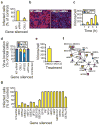RNA interference screen for human genes associated with West Nile virus infection
- PMID: 18690214
- PMCID: PMC3136529
- DOI: 10.1038/nature07207
RNA interference screen for human genes associated with West Nile virus infection
Abstract
West Nile virus (WNV), and related flaviviruses such as tick-borne encephalitis, Japanese encephalitis, yellow fever and dengue viruses, constitute a significant global human health problem. However, our understanding of the molecular interaction of such flaviviruses with mammalian host cells is limited. WNV encodes only 10 proteins, implying that it may use many cellular proteins for infection. WNV enters the cytoplasm through pH-dependent endocytosis, undergoes cycles of translation and replication, assembles progeny virions in association with endoplasmic reticulum, and exits along the secretory pathway. RNA interference (RNAi) presents a powerful forward genetics approach to dissect virus-host cell interactions. Here we report the identification of 305 host proteins that affect WNV infection, using a human-genome-wide RNAi screen. Functional clustering of the genes revealed a complex dependence of this virus on host cell physiology, requiring a wide variety of molecules and cellular pathways for successful infection. We further demonstrate a requirement for the ubiquitin ligase CBLL1 in WNV internalization, a post-entry role for the endoplasmic-reticulum-associated degradation pathway in viral infection, and the monocarboxylic acid transporter MCT4 as a viral replication resistance factor. By extending this study to dengue virus, we show that flaviviruses have both overlapping and unique interaction strategies with host cells. This study provides a comprehensive molecular portrait of WNV-human cell interactions that forms a model for understanding single plus-stranded RNA virus infection, and reveals potential antiviral targets.
Figures




References
-
- Brinton MA. The molecular biology of West Nile Virus: a new invader of the western hemisphere. Annu Rev Microbiol. 2002;56:371–402. - PubMed
-
- Brass AL, et al. Identification of host proteins required for HIV infection through a functional genomic screen. Science. 2008;319:921–6. - PubMed
-
- Ng TI, et al. Identification of host genes involved in hepatitis C virus replication by small interfering RNA technology. Hepatology. 2007;45:1413–21. - PubMed
Publication types
MeSH terms
Substances
Grants and funding
- AI062773/AI/NIAID NIH HHS/United States
- U54AI057159/AI/NIAID NIH HHS/United States
- U54 AI057159/AI/NIAID NIH HHS/United States
- HHMI/Howard Hughes Medical Institute/United States
- R01 AI041440/AI/NIAID NIH HHS/United States
- R01 AI032947/AI/NIAID NIH HHS/United States
- T32 AI007526/AI/NIAID NIH HHS/United States
- R01 AI062773/AI/NIAID NIH HHS/United States
- P30 DK040561/DK/NIDDK NIH HHS/United States
- U54 AI057156/AI/NIAID NIH HHS/United States
- AI07526/AI/NIAID NIH HHS/United States
- U01 AI070343/AI/NIAID NIH HHS/United States
LinkOut - more resources
Full Text Sources
Other Literature Sources
Medical

